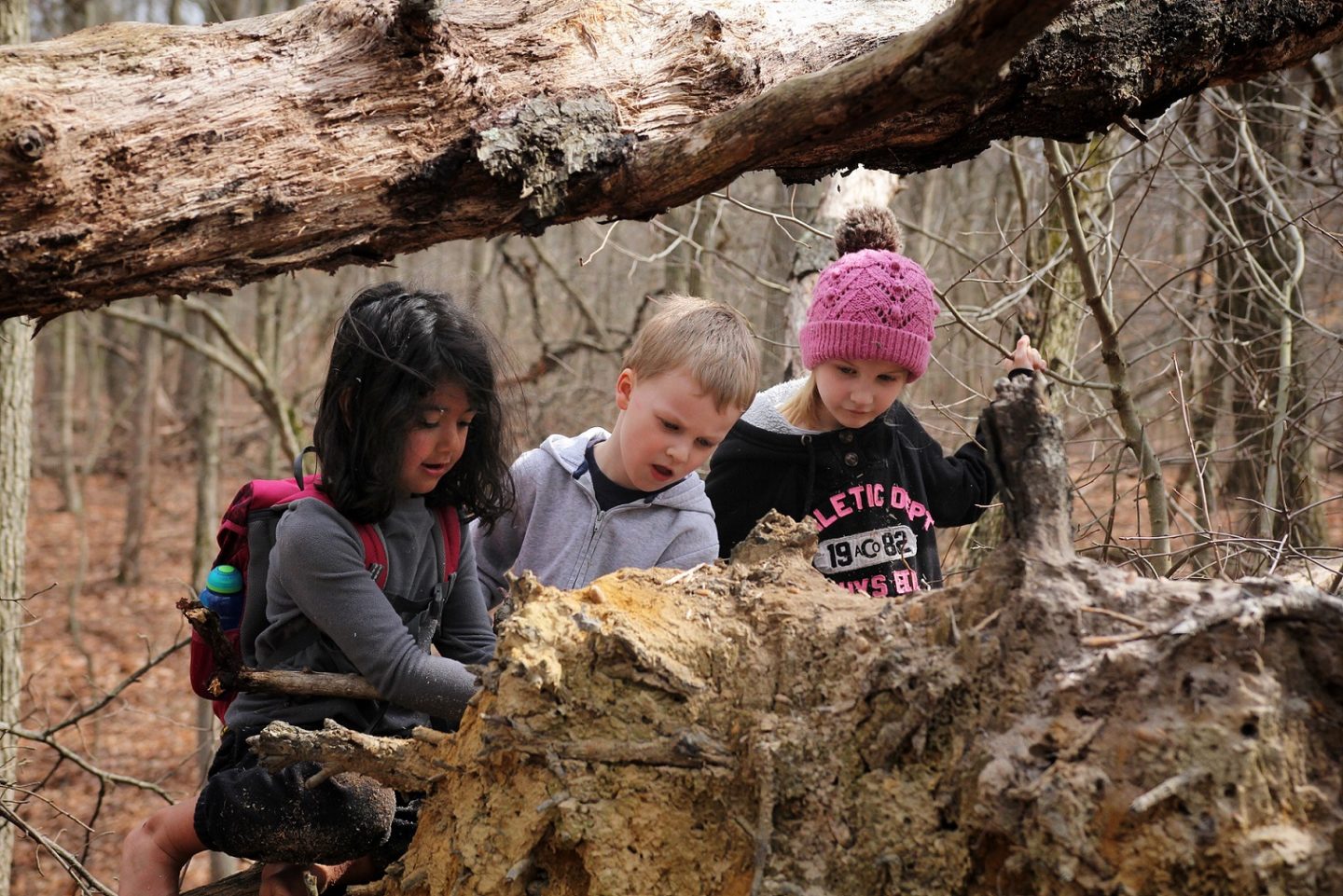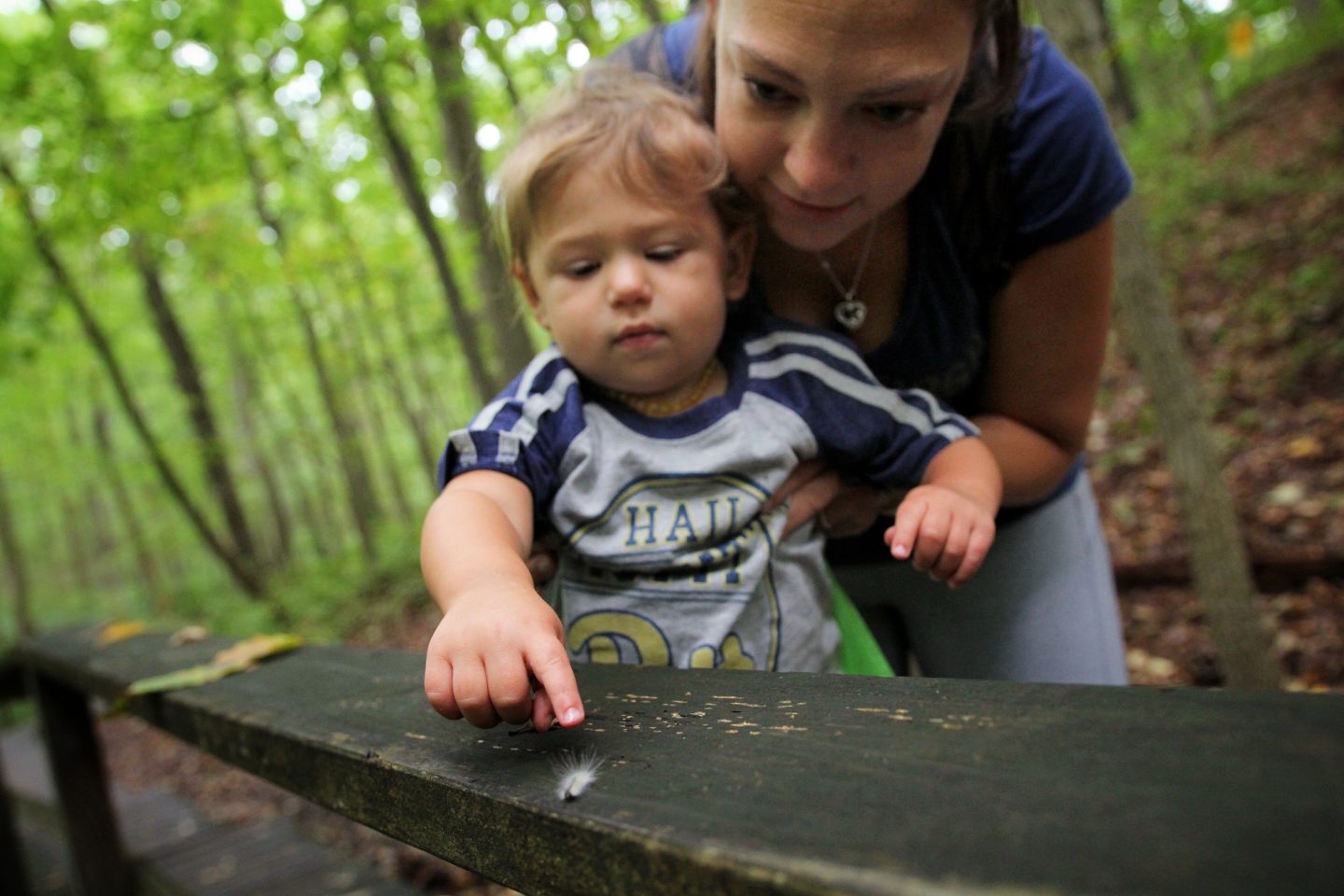
Engaging with the natural world regularly is essential for building and maintaining a connection with it — especially for young children. One recent study showed that Americans spend 93 percent of their lives indoors. As people become more disconnected from nature, the need to get children outdoors has never been more urgent. Most importantly,
getting outdoors benefits children as well as nature. Spending time in nature has many benefits, from improving concentration and short-term memory to diminishing stress and enhancing creativity. Fostering kids' knowledge and understanding of wild flora and fauna and the interconnectedness of all living things is essential to connecting them in a meaningful way with the natural world.
Time on the trail is a great opportunity to teach children about local wildlife as well as the importance of protecting it. Take advantage of their natural curiosity about their surroundings to weave together a story about the plants, animals and geological features you see along the trail. Take cues from the sights, sounds and smells of nature while guiding them in this fun learning experience.
Look for these opportunities on the trail:
Fauna
Animal signs are often found on hiking trails as animals, like humans, prefer to take the path of least resistance. Although the types of fauna vary based on where you are, deer signs are commonplace — everything from their hoof prints, which look similar to quotation marks, to their poop resembling little pellets, to chunks of hair, to tree rubs where they’ve rubbed their antlers.
Use what you find to share your knowledge of wildlife with kids. Bones tell the story of an animal that fell prey to a predator. Overturned logs, possibly the work of a black bear searching for insects to eat. Egg shells, the entry of a new baby bird — or turtle — into the world.
Flora
Plants provide an easy opportunity to educate children, as they are all around us. Like fauna, species of flora also vary from region to region, but some plants are native to most areas of the U.S., such as many varieties of wildflowers — the Black-eyed Susan, for instance. Use these and other flowers you see along the trail to talk about how these plants help sustain bee populations by providing them with essential nutrients.
Other plants allow for a more sensory experience. In the heart of summer, you can introduce kids to the sweet and sometimes tart taste of ripe, wild blackberries. You could also use this time to teach them about plants that are not OK to eat, such as the bright red berries of the Holly plant, which are poisonous.
Geology
The terrain, as well as the geological features of the land, reveal many things. Whether you live in the grasslands or wetlands, mountainous or hilly terrain, near rivers or lakes or the ocean, these natural features tell stories of how the land was shaped and continues to be shaped. Trails — especially those that meander diverse landscapes — pave the way for many questions and explanations about the land’s natural resources and forms. Sinkholes and springs often indicate the presence of caves. Fossils in stones show ancient fish in what was once likely a freshwater sea. Canyons tell of rock carved by gushing rivers over millions of years.
Awareness
If you are quiet — this may be tough for those with small children — you’ll be able to take in the sights, sounds and smells of nature. Beyond the chance to witness birds, deer or other animals on the trail, hushed movement allows you to take in the sounds of water trickling through a creek, down a waterfall or telling of recent rain. Feel the wind whipping through the wood indicating an approaching storm. Listen to a woodpecker on a far-off tree, working to gather food, create a nesting site or attract a mate.

The smells of the natural world are no less notable, particularly that of pine or cedar trees and their needles, which make a soft carpet of the forest floor. The musty aroma of rotting logs and leaves activates the senses, revealing one of nature’s most important processes — the cycle of decomposition and re-growth. As trees break down, they are recycled back into the soil, providing vital nutrients for other plants to use.
These aspects of nature offer opportunities for not only engaging children but also teaching them about the natural world and its wild flora and fauna. Together, these elements help show the interconnectedness of all living things and how they need each other to prosper. Geological formations and plants provide habitat for animals and insects. The animals prey on plants and other animals, and the water continuously offers nourishment for all.
So the next time you hit the trail with your kids, seize the moment for what it is: a learning opportunity. Whether you choose storytelling, a scavenger hunt or other means, plant the seed to help them grow a lifelong connection to the natural world.
What are some ways you encourage and teach your kids to explore the natural world during hikes? Share your ideas in the comments below!
Read more
Photos by Ali Chandra.

Alexandra Vollman is a native Missourian and editor with a passion for the outdoors. When she isn’t wielding her red pen, she’s exploring the wilderness with her husband and 9-month-old daughter or churning out articles for her website,
ModernConservationist.com.
 Engaging with the natural world regularly is essential for building and maintaining a connection with it — especially for young children. One recent study showed that Americans spend 93 percent of their lives indoors. As people become more disconnected from nature, the need to get children outdoors has never been more urgent. Most importantly, getting outdoors benefits children as well as nature. Spending time in nature has many benefits, from improving concentration and short-term memory to diminishing stress and enhancing creativity. Fostering kids' knowledge and understanding of wild flora and fauna and the interconnectedness of all living things is essential to connecting them in a meaningful way with the natural world.
Time on the trail is a great opportunity to teach children about local wildlife as well as the importance of protecting it. Take advantage of their natural curiosity about their surroundings to weave together a story about the plants, animals and geological features you see along the trail. Take cues from the sights, sounds and smells of nature while guiding them in this fun learning experience.
Look for these opportunities on the trail:
Engaging with the natural world regularly is essential for building and maintaining a connection with it — especially for young children. One recent study showed that Americans spend 93 percent of their lives indoors. As people become more disconnected from nature, the need to get children outdoors has never been more urgent. Most importantly, getting outdoors benefits children as well as nature. Spending time in nature has many benefits, from improving concentration and short-term memory to diminishing stress and enhancing creativity. Fostering kids' knowledge and understanding of wild flora and fauna and the interconnectedness of all living things is essential to connecting them in a meaningful way with the natural world.
Time on the trail is a great opportunity to teach children about local wildlife as well as the importance of protecting it. Take advantage of their natural curiosity about their surroundings to weave together a story about the plants, animals and geological features you see along the trail. Take cues from the sights, sounds and smells of nature while guiding them in this fun learning experience.
Look for these opportunities on the trail:
 The smells of the natural world are no less notable, particularly that of pine or cedar trees and their needles, which make a soft carpet of the forest floor. The musty aroma of rotting logs and leaves activates the senses, revealing one of nature’s most important processes — the cycle of decomposition and re-growth. As trees break down, they are recycled back into the soil, providing vital nutrients for other plants to use.
These aspects of nature offer opportunities for not only engaging children but also teaching them about the natural world and its wild flora and fauna. Together, these elements help show the interconnectedness of all living things and how they need each other to prosper. Geological formations and plants provide habitat for animals and insects. The animals prey on plants and other animals, and the water continuously offers nourishment for all.
So the next time you hit the trail with your kids, seize the moment for what it is: a learning opportunity. Whether you choose storytelling, a scavenger hunt or other means, plant the seed to help them grow a lifelong connection to the natural world.
What are some ways you encourage and teach your kids to explore the natural world during hikes? Share your ideas in the comments below!
The smells of the natural world are no less notable, particularly that of pine or cedar trees and their needles, which make a soft carpet of the forest floor. The musty aroma of rotting logs and leaves activates the senses, revealing one of nature’s most important processes — the cycle of decomposition and re-growth. As trees break down, they are recycled back into the soil, providing vital nutrients for other plants to use.
These aspects of nature offer opportunities for not only engaging children but also teaching them about the natural world and its wild flora and fauna. Together, these elements help show the interconnectedness of all living things and how they need each other to prosper. Geological formations and plants provide habitat for animals and insects. The animals prey on plants and other animals, and the water continuously offers nourishment for all.
So the next time you hit the trail with your kids, seize the moment for what it is: a learning opportunity. Whether you choose storytelling, a scavenger hunt or other means, plant the seed to help them grow a lifelong connection to the natural world.
What are some ways you encourage and teach your kids to explore the natural world during hikes? Share your ideas in the comments below!
 Alexandra Vollman is a native Missourian and editor with a passion for the outdoors. When she isn’t wielding her red pen, she’s exploring the wilderness with her husband and 9-month-old daughter or churning out articles for her website, ModernConservationist.com.
Alexandra Vollman is a native Missourian and editor with a passion for the outdoors. When she isn’t wielding her red pen, she’s exploring the wilderness with her husband and 9-month-old daughter or churning out articles for her website, ModernConservationist.com.




Comments